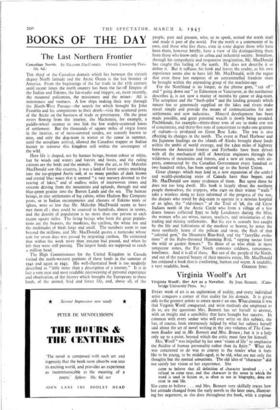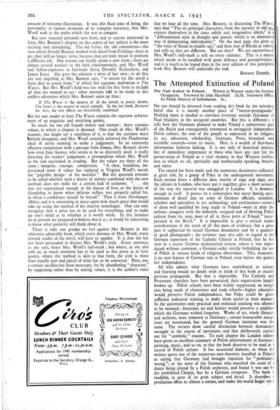Virginia Woolf's Art
EVERY work of art is an exploration of reality, and every individual artist conquers a corner of that reality for his domain. It is given only to the greatest artists to annex more flan one. What domain it was that Virginia Woolf conquered, and what methods she employed to do so, are the questions Mrs. Bennett has set herself to answer, with an insight and a sensibility that have brought her success. In common with every seeker who will ever write on this subject, she has, of course, been enormously helped by what her subject herself said about the art of novel writing in the two voltunes of The Com- mon Reader and in Mr. Bennett and Mrs. Brown ; but it is a help only up to a point, beyond which the critic must fare for himself.
Mrs. Woolf" was impelled by her own' vision of life' to emphasise the fluidity of human personality rather than its fixity.". What she was concerned to do was to convey to the reader what it feels like to be young, to be middle-aged, to be old, what are not only the thoughts bnt the mental sensations. The old idea of "character" did not satisfy her vision or her experience. She
came to believe that all definition of character involved . . a refusal to come near, and that character in the sense in which the word is used in fiction or, as often as not in biography, does not exist in real life.
She came to believe. . . and Mrs. Bennett very skilfully traces how her attitude changed from the early novels to the later ones, glustrat- ing her argument, as she does throughout the book, with a copiow
amount of welcome illustration. It was this fluid state of being, the personality at various moments of its complex existence, that Mrs. Woolf took as the realm which she was to conquer.
But new material demands new form, and to anyone interested in form, Mrs. Bennett's chapter on this aspect of her subject is the most exciting and stimulating. The old forms, the old conventions—the ones which Arnold Bennett worked with dated from Fielding—have to go ; they will no longer serve, because they are tools meant to perform a different job. One person can hardly create a new form ; there are always several workers in the field simultaneously, and Mrs. Woolf had fellow-explorers in Gertrude Stein, Dorothy Richardson, and James Joyce. She gave the solution a twist of her own ; to do this she was impelled, as Mrs. Bennett says, "to invent for the novel a form akin to poetic form," of which her supreme realisation is The Waves. But Mrs. Woolf's field was too wide for this form to include all that she wanted to say : other attempts htd to be made in this endless adventure which Mrs. Bennett sums up thus : If The Waves is the nearest of all the novels to poetic drama, The Years is the nearest to social comedy. In the last book, Between the Acts, the two effects are beautifully combined.
But for one reader at least The Waves remains the supreme achieve- ment of an exquisite and enriching genius. So much for our old friends matter and manner : there remains values, to which a chapter is devoted. One result of Mrs. Woolf's manner, one might say a condition of it, is that the narrator must Wmirely disappear, and Mrs. Woolf certainly achieved the Flaubertian ideal of never seeming to make a judgement. In an extremely effective comparison with a passage from Emma, Mrs. Bennett shows how even Jane Austen, who seems to be so discreetly aloof, is really directing the readers' judgement, a presumption which Mrs. Woolf in the end succeeded in evading. But the values are there all the same ; integrity, courage, compassion. "A clear, fastidious, im- passioned sense of values has replaced in Virginia Woolf's novels the 'palpable design' of the moralist." But the question remains to be asked whether such a theory of artistry combined with the new method, does not make for a certain lack of economy. " . . she was not experienced enough in the finesse of love, or the duties of friendship, to know when delicate raillery was properly called for, or when a confidence should be forced." That is from Northanger Abbey, and it is interesting to muse upon how much space that would take up using the method of the interior monologue. One can only recognise that a price has to be paid for everything, and to make up one's mind as to whether it is worth while. In this instance we at present are prepared to believe that it is'; it would be interesting to know what posterity will think about it.
There is only one grudge we feel against 'Mrs Bennett in this otherwise admirable book, which every devotee of Mrs. Woolf, every shrewd reader of the novel, will have to ponder. It is that she has not been persuaded to discuss Mrs. WoolFs style. Every sentence, as she says, bears Mrs. Woolf's hall-mark ; but where, as she also tells us, as much attention has to be paid to this prose as to lyric poetry, where the method is akin to that form, the style is more than usually part and parcel of what has to be conveyed. Here, too, a certain sacrifice has been necessary, for by abandoning "character," by suggesting rather than by stating values, it is the author's voice
that we hear all the time. Mrs. Bennett, in discussing The Wat,L says that "The six principal characters, from the nursery to old ag, express themselves in the same subtle and imaginative idiom," in I "differentiated style in thought and speech, which is an alternative way of demarcating individuality." On the next page she gives us "the voice of Susan in middle age," and then that of Rhoda at school, and tells us they are different. But are they? We are unconvinced. Mrs. Woolf's hall-mark is still on every sentence. This is a matter which needs to be handled with great delicacy and perceptiveness ; and it is much to be hoped than in the next edition of this percipient book Mrs. Bennett will undertake the task. BONAMY DOBRAE.



























 Previous page
Previous page